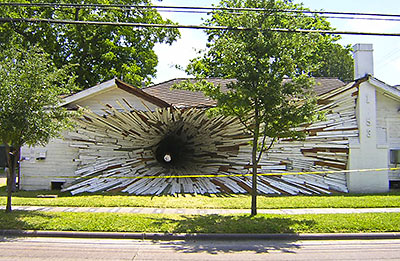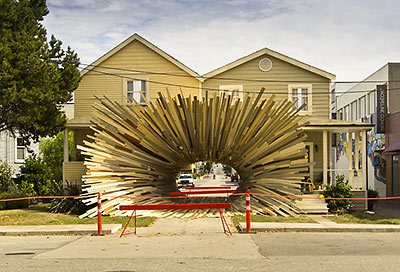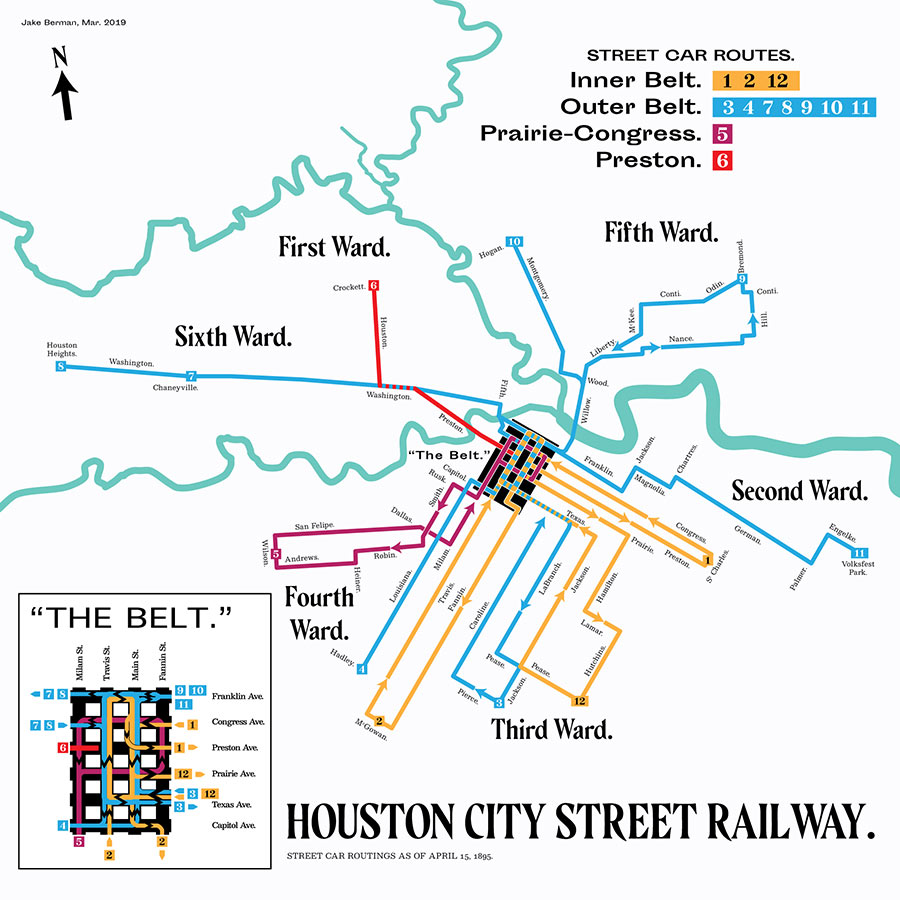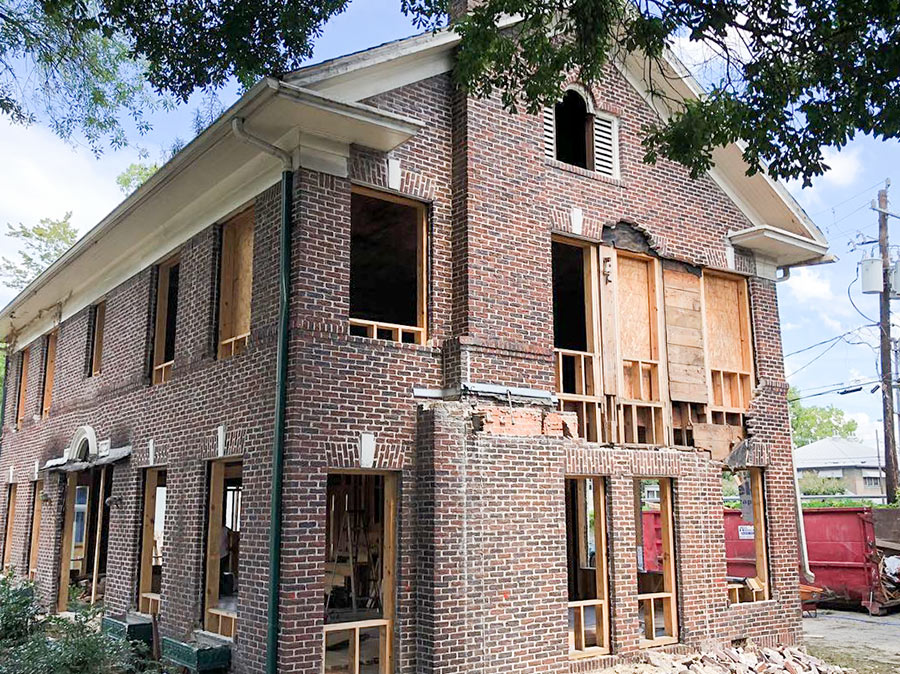That there’s some pretty bad Feng Shui going down in this commercial for Honda, which was filmed in Vancouver and shown on teevee and the web beginning last October. The man behind the wheel of the CR-V sure is driving some bad chi into the gullet of the far-from-the-prairie home at the end of the T-intersection, to the encouraging narration of Garrison Keillor. But isn’t the house kinda asking for it anyway, what with all that glimmering vortex-popping and all?
And gee, doesn’t the hole stabbing through the house look a heck of a lot like . . . that temporary sculpture that stood on Montrose Blvd. in Houston a few years back? Portal to another dimension? Naah — from here it looks more like a shortcut to Grant St.
***

This was demolition artists Dan Havel and Dean Ruck’s 2005 shiplap installation, carved out of a couple of doomed bungalows on the corner of Willard St. and Montrose Blvd. owned by the Art League of Houston. They called it “Inversion.” It stopped a lot of traffic on Montrose (back when there wasn’t as much of it); later, images of the sculpture were plastered onto the storefront windows of the Inversion Coffee House, which was named after the work and now stands on the same site at 1953 Montrose. Then last year, images of Inversion attracted the attention of Rogue Films and the Mill Group, the British production team planning Honda’s ad.
Havel and Ruck say Rogue contacted them and asked them permission to use a design similar to theirs — which the Houston artists had copyrighted. But the mockups the company sent to them didn’t look so similar to Inversion, they report. So Ruck told Rogue he didn’t think it was a copy of their design.
But when Havel and Ruck were given a preview of the ad shortly before it was completed, it looked to them as if their design had, in fact, been copied. That’s what their lawsuit says, anyway — they filed suit late last week against Rogue and Honda for copyright infringement. Here’s a photo of the house used in the commercial:

Rogue did offer them what the Houstonians considered a “token amount” of compensation shortly before the ad went live, but Ruck and Havel turned it down; the lawsuit notes they never gave Honda permission to use their design.
- Honda Leap [The Mill via YouTube]
- The Mill, Sam Brown and mcgarrybowen take a leap into the unknown with ‘Do More New’ for Honda [The Mill]
- Dan Havel and Dean Ruck: Inversion [Art Lies]
- Honda sued for allegedly using sculpture in commercial without permission [The Southeast Texas Record]
- Artists behind iconic Houston sculpture sue Honda over ad [Houston Chronicle]
- Previously on Swamplot: Explosive Fifth Ward Bungalow Bandshell Just About Ready for Its Breakout Jam Session, Fifth Ward Journey: Since When Did This House Become Art?, DeLuxe Theater Breakaway Sculptors: All They Want for Christmas Is Some 117 Siding, Given and Taken: The Hole in the House and the Museum Piece, Does Your Home Belong in a Museum?
Images: The Mill via YouTube (video), Trevor Dykstra (Vancouver house) [license], Brittanie Shey (Inversion House)





How ironic that the commercial uses Garrison Keillor’s voice – the epitome of earnest authenticity – overlaid upon their intellectual theft. I hope Havel and Ruck get a nice chunk of change out of this….
I would imagine they will get a pretty nice check and Honda will add notes at the end of commercial, “inspired by…” Similar to what ATT did for Christo and Jean-Claude after they ripped off their wrapping of buildings in orange fabric.
I didn’t know artists owned a copyright of every hole in the wall, literally.
So wait, the company said, “We think you’re copying your design and we want permission,” and sent them good faith pictures of their work at the development phase, is that right? And the artists actually told them, “It’s not that close, so carry on without us.” The studio did carry on, and apparenlty even showed them previews, and NOW they want to calls ‘backsies’? No, I think not.
These guys aren’t new to commercial production; they know the vast gulf that sits between development sketches and the final product, and they chose not to be involved in spite of being told, “This will wind up looking like Inversion when we’re done.” They turned down the monetary offer. That makes them big sillies, not naifs being suckered by the Man.
We didn’t see the development sketches. Sure sounds to me like any kind of “vortex” in a house made from what looks like exterior siding is a clear theft of concept. If the development sketches minimized that design on purpose, or, even in the best of faith, the concept changed significantly in development, then there are grounds for a suit. And they filed the suit after seeing the preview. Whether, of course, the suit will actually be successful will have to wait until the trial.
Sihaya
The company showed them mockups that were different from their actual work. Then when the commercial was finished–voila–it was their work–the Inversion– afterall.
They were duped.
The producers CAME TO THEM with the sketches. If the producers had wanted to dupe them, why would they have come to Havel and Ruck in the first place, with an offer to make an arrangement for permission?
There is more to the story than you know or understand.
Oh, the old, “Well, you’re just ignorant, but I won’t give any information to fix that,” retort. Well then the debate is obviously done.